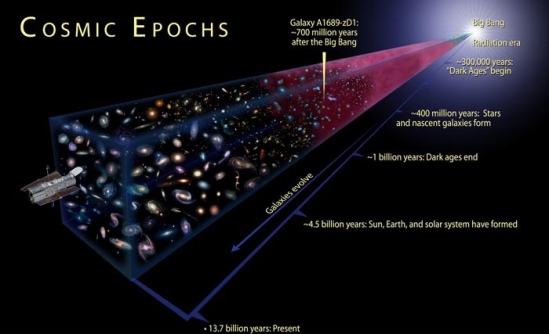I never really saw “all the stars, and all the planets” as being “ejected” or “blown out” of some mysterious point during the Big Bang.
We hear it all the time from Cosmologists these days. “We are all made of Stardust” when they are talking about the known universe.
They say this, because they know how stars work, and what goes on inside them. One easy way to describe this would be for you to imagine; “a giant factory where every molecule in the Periodic Table of Elements is created one at a time, from heaviest, to lightest, and then “spit’s them out.”
These particles then accumulate in space until enough of the matter is affected by gravity and other forces creating the circumstances needed to form a core, etc.
I’ve said before, and I will say it again.
“Once mapped and understood, we are going to discover that the stars simply represent their place in the universe as the “Factories of Matter.” (There is going to be somewhat of a pattern to them all as well as we “Rediscover” God in his even “grander” design. More later)
Knowing this about stars makes the following discovery seem rather obvious, yet it “IS” considered to be new. (Cutting edge theory, bold new idea, recently confirmed, etc.)
I’m just glad they’ve started to figure this out. Now maybe they can better apply the theories of movement in space, etc. and “REALLY” start to learn some stuff!
Core accretion model of planet formation allows for more accurate theories
http://lanl.gov/science-innovation/science-features/planetary-formation-theory.php
Recent research by Jarrett Johnson and Hui Li of LANL’s Nuclear and Particle Physics, Astrophysics and Cosmology group suggests that the first planets in the universe formed well after the first generations of stars. The scientists calculated the minimum metallicity that must be present in the dusty disks surrounding newborn stars in order for planets to take shape.
Astronomers use the term “metallicity” to refer to elements heavier than hydrogen and helium, such as oxygen, silicon and iron. Because the heavy elements required for assembling the cores of planets were not produced in the Big Bang, they must have been produced instead by fusion reactions within early generations of stars and supernovae. The scientists’ calculations suggest that the amount of heavy elements produced by the first generation of stars was not enough for planets to form around the second generation of stars; instead, numerous generations of stars were likely required to produce the material from which the first planets formed.
Core accretion model of planet formation
Johnson and Li based their work on the core accretion model of planet formation, in which dust grains in a protostellar disk coagulate into planetesimals, which then assemble into planets with solid cores. The scientists developed a simple calculation of the critical metallicity—the minimum amount of heavy elements to form planetesimals during the early dust coagulation phase of the model. The researchers focused on what they consider to be the key processes that set the timescale required for planetesimals formation at low metallicity. They compared the time required for dust to settle into the midplane of a circumstellar disk with the disk lifetime. The high radiation flux from the central star disperses the lighter elements in the disk, which reduces the lifetime of the disk. The researchers conclude that the more significant factor in determining whether the conditions exist for planet formation is the metallicity of the disk, rather than the grain-size distribution. The critical metallicity is also a function of distance from the host star.
Comparison with astronomical observations
Johnson and Li do not expect planet formation in the core accretion model for the “Forbidden zone”—the region below critical metallicity. The researchers tested this prediction against observational data that astronomers have collected on hundreds of planets orbiting distant stars. The evidence indicates that planet formation takes place preferentially at high metallicity, and the lifetimes of circumstellar disks are shorter at lower metallicities. The calculated results are consistent with the observational data and support one of the main models of the formation of the Solar System. Because their theory is based on current ideas of how planets form around stars, it may need revision if it is incompatible with any planetary systems that are discovered in the future.
Predictions for the types of planets
The researchers’ calculations also predict the properties of the first planets. The scientists expect that the planets formed around the first low-mass metal-enriched stars were likely to have been too small and too close to the star (too hot) for life. The first Earth-like planets, which may have hosted the first life in the universe, only could have formed once the abundance of heavy elements rose to a level of at least 10 percent of what is observed today in the local universe. This result also implies that the first Earth-like planets may have formed around stars slightly more massive than the Sun. Because more massive stars burnout faster than less massive ones, any life that evolved on these planets may have already perished with the death of its host star, which may have lived only 4 billion years compared to the 10 billion year lifetime expected for the Sun. The researchers state that the formation of Earth-like planets is not itself a sufficient prerequisite for life. Early galaxies contained strong sources of life-threatening radiation, such as supernovae and black holes. Therefore, they conclude that the conditions for life emerged only after the earliest epoch of galaxy formation.
The Astrophysical Journal will publish this research. The Laboratory Directed Research and Development Program (LDRD) funded the research, and Jarrett Johnson is supported by a Director’s Postdoctoral Fellowship. The work supports the Lab’s Information Science and Technology science pillar.


I wrote the first one on 11/5 /2011 before I had heard of any of this. The one after a few weeks ago. Again, before I had heard any of this. Personally, I think that is rather coincidental.